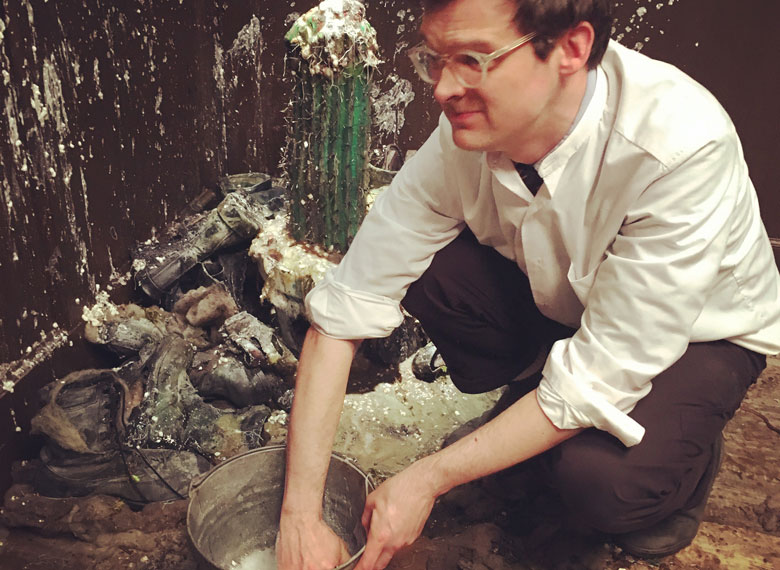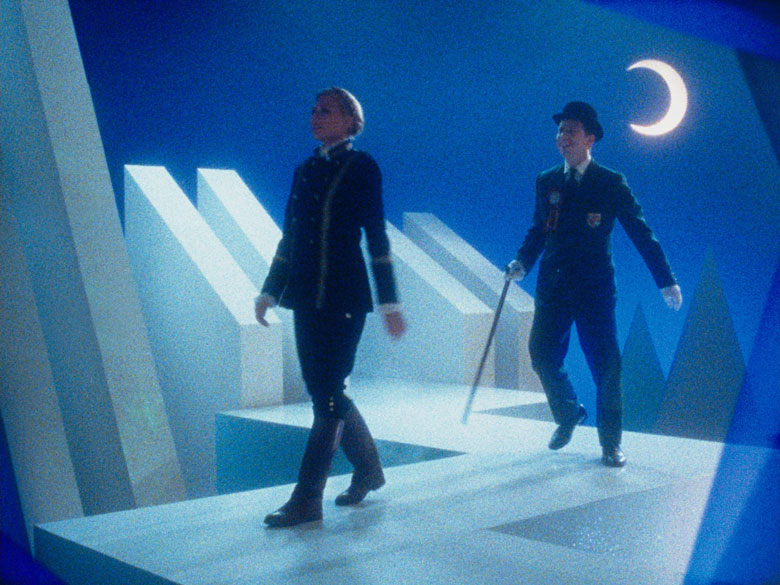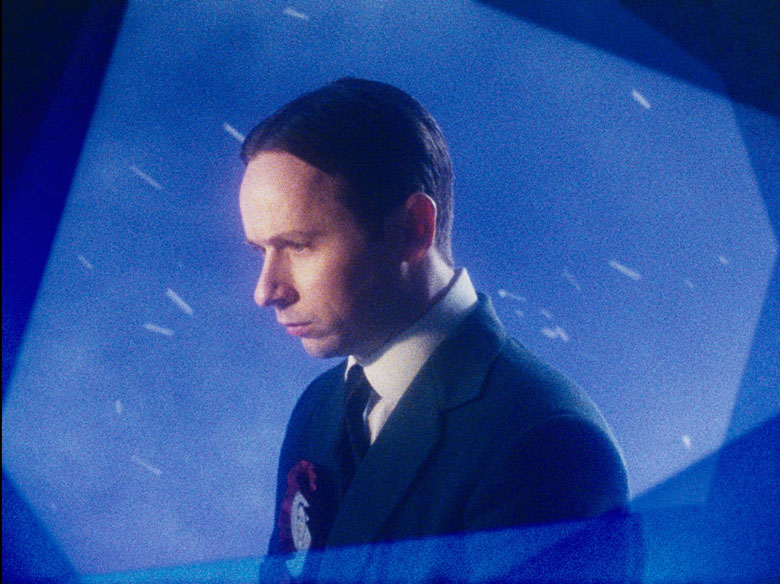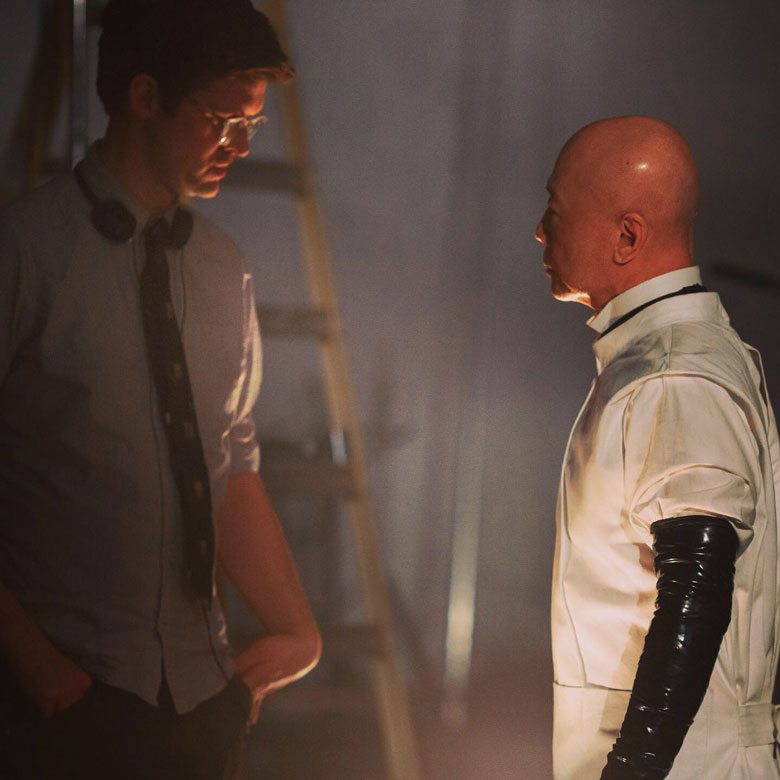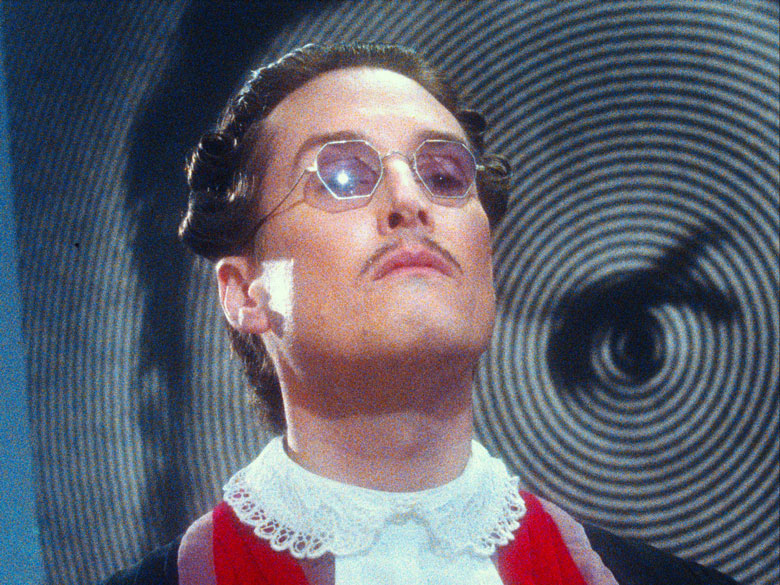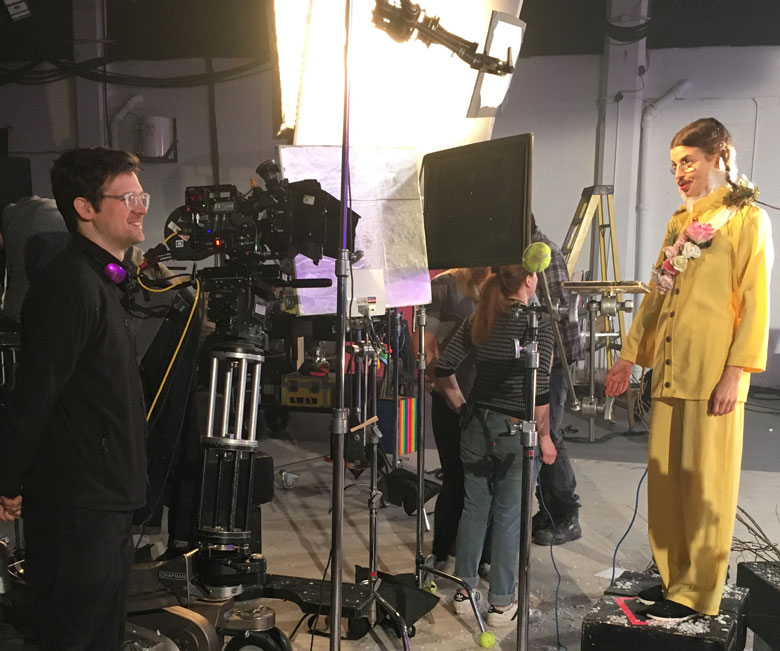Matthew Rankin’s new film The Twentieth Century (2019) is an acid-trip biopic of William Lyon Mackenzie King, Canada’s longest-serving Prime Minister, full of nightmarish Canadiana, power-mad obsession, and irreverent humour. Rankin’s style is rooted in the Winnipeg Film Group, as well as influences from Monty Python’s animation, and the Czeck filmmaker Karel Zeman. The Twentieth Century screened at TIFF and CIFF in 2019.
The film is a beautiful mixture of history, satire, dedication, and deep questioning. Rankin has been absorbed in all of the aesthetic power of Winnipeg, and taken it to a new level, one that speaks to a national character. While watching The Twentieth Century, I looked back on the Canada my grandparents knew, my parents, and what kind of Canada we live in today. Rankin brings considerable talent in animation, film knowledge, and most importantly, a sense of humour rooted in suffering and pathos to the story of William Lyon Mackenzie King.
When we met at a cafe in Calgary, he commented on how much he loved the sculptures at Century Garden on 8th street, currently under construction. He had passed by the gardens on his way to meet me. We talked about how they will likely lose their strange aesthetic, part of a larger trend in Calgary to destroy what makes it unique in the name of beauty or progress. Not surprising that he loved the gardens since they look like a set from one of his films.
Guillaume Carlier: You said something that I really liked. That Canada is this bedtime story we tell ourselves. Is that how you’ve come to understand Canadian history? I understand that you’re a history major, that you studied Canadian history.
MAtthew Rankin: Well, how does this all work? I went to McGill University as an undergraduate. I was initially going to study English, then I found myself preoccupied by Québec history and Québec nationalism, so I ended up doing my degree in history, Québec history. And then I sort of couldn’t stop and did a Masters degree at Université Laval in Québec City. By this point, I had learned French. When I arrived I didn’t speak French, and now I live mainly in French. So Québec [...] started to exert a massive influence on how I was seeing everything. Cinema especially. And Canada in general. It brought me in contact with nationalism as a story we tell ourselves. There’s nothing organic about nationhood, it is a method we have devised for organizing the world.
GC: We learn it in school, we’re taught the steps.
MR: Exactly, and to some degree it can be a source of great collective action, and emancipation, but it can also be very oppressive. It can shrink you, oppress you.
GC: That’s right. Québec experienced that as a culture. Fought back against it.
MR: So the idea of artifice of nation became exciting to me. And of course this movie is about the earliest time of Confederation. Alberta wasn’t even a province. The nation was being built. And meanings were being assigned to it. And identities were being grafted onto a landscape that had no connections to it. Like the Legislative Building of Manitoba was built in Winnipeg in 1912, in this very classical architectural design, and it really looks like it was always there. When it was built, Winnipeg was a swamp. Empire was grafted upon the earth. And it was made to look like it was always there. So the film plays with the artifice of nationhood and nation-building.
GC: I wouldn’t describe your film as a history major makes a film. It seems like you’re very film literate. You’ve steeped yourself in the Winnipeg film tradition. But it also seems like you’re playing around with high-concept art. Are you studying film at the same time as studying history?
MR: I was always making films. Growing up, I joined the Winnipeg Film Group and learned how to use the equipment. I made little animated films, things like this [The Twentieth Century], just playing around as people do. But then as I went along, kind of while I was studying, I came to the conclusion was that I was not a scientist. My interest in history was an artistic interest and not a scientific interest. I was more interested in historical processes that couldn’t be measured through social science. So then I decided I had to choose and commit.
GC: So, the history of Canada is fermenting in your mind, and then Mackenzie King comes along. When does everything begin to converge with film?
MR: Well, I read his diary in microfiche over the course of many years. It’s long. Hundreds of thousands of pages long.
GC: Which sort of speaks towards a manic quality to the guy.
MR: Yeah, well I understand that.
GC: Because who in politics has time to write every night? Like fifty pages, that’s just insane.
MR: That’s true. I think maybe back then, being a Prime Minister was more like being a Rotary club president. Not sure that’s quite what it is now. But he was a compulsive diarist, in a large part because he was so lonesome. He was a lifelong bachelor. He had all sorts of obsessions and compulsions, he was a very work driven person, very lonely, and he was very puritanical as well. So the diary was sort of a way to process the chaos of his life. It was an introspective space. Myself, I’m also a lifelong diarist. I’ve always been drawn to the form, and particularly his diary as a young person. He’s much less guarded than [...] later on in his life.
GC: Did you notice a tonal shift when he became Prime Minister?
MR: A little bit. At a certain point he was planning to write his memoirs, so he was using his diary as a first draft in a way. He starts to become conscious that some people might read this, whereas early on he’s not conscious of that at all.
GC: I’ve always been interested in William Lyon Mackenzie King only on a Wikipedia level. I’ve never done the deep dive. But when you get to the main points of his life, he almost seems, in my imagination, bullish, very masculine, very big. But when I saw your film, his portrayal, his performance, his face is so postcard perfect. I thought, that’s not at all what I had in mind, even his name suggests big. He was a big guy, right?
MR: He was corpulent, yes! We thought about maybe putting Dan [Beirne] in a fat suit, but decided against it cause it restricted his movements and King’s weight was up and down in his youth. I don’t really think of him as bullish, though certainly was very cunning. There’s a lot of times in his career where he had to choose between either acting what he knew to be right or protecting his own power. And he always chose to protect his power. He was a moderate, which is in a weird way kind of an accomplishment. He’s all about the radical center. To occupy the political center is to disappoint a lot of people but also win them over by default. We might say that compromise has a diplomatic virtue. But less generously, we might also see that the centrist compromise is about visionless opportunism.
GC: There’s something so Canadian about that.
MR: Yes! We’re living in this very binary era and the elastic is really stretching to the snapping-point. So the centre is in a much more fragile space than it used to be. It’s interesting to think about the centre. Binary-transcending brokerage politics has assured the survival of many generations of Canadian politicians, but the tradition kind of really begins with Mackenzie King.
GC: He always seemed to be in the right place at the right time. Isn’t he the longest serving prime minister of all the commonwealth? 20 years?
MR: That’s right, 22 years.
GC: But he’s also known for not allowing Jews into Canada during WWII.
MR: That’s right, he rejected Jewish refugees, he imprisoned Japanese Canadians. He made reprehensible decisions. The case of the Jewish refugees is a very good example of him protecting his own power, because he knew that was wrong. He confesses in his journal that he understood it was right and just for Canada to welcome refugees. But he also understood that there was a cultural Anti-Semitism to the Canadian electorate and so he saw no way to win any political capital by leading against public opinion. Indeed, he thought it would weaken his power. And so he elected to do nothing and send the refugees back to Europe.
GC: Do you find in telling Mackenzie King’s story, there’s something inherently Canadian about it? The good and the bad. Because he’s so centered.
MR: I mean,[the film] does look at Canada as this sort of self-gratifying, self-pleasuring enterprise. I think he does incarnate that. This sort of complacency and self-satisfaction, and meaninglessness (laughs).
GC: It’s true, this American idea of freedom is a narrative that every American and immigrant can agree on. I don’t know what our collective narrative is. Good government?
MR: Peace, Order, Good Government. It’s almost administrative.
GC: There’s a patriotic line, in the world of the film. You call it “The Disappointment.”
MR: Yes, like a rallying idea, like a dream, it’s a collective myth to be aspired to.
GC: Were you sitting on this idea for a long time?
MR: A little bit. I kept making stuff while I was studying. There was always art that I was making. I love to draw, and I was making films. And then I was developing a feeling that if I went really deep with that, as I was doing my academic work, there was a well that I could dive down. The well was kind of deep, and I could go down that well.
GC: Let’s talk specifics. How long were you sitting on the idea for The Twentieth Century? What was your funding structure? Did you have to start and stop a lot?
MR: I don’t remember writing a script. (laughs) One was written. I showed it to a few producers in Montréal. I made another film with the producer of this film, Gabrielle Tougas-Fréchette, called Mynarski Death Plummet (2014).1It just became very normal to make a feature with her. She’s a great leader. A spiritual warrior. So we amassed some money. I think it all comes down to the producer, the budget, and the filmmaker being coherent. You know, cool producer, getting stuff going. I’ve done a bunch of shorts, it was time to make something long. And the budget wasn’t that much. So all those things made something coherent. We were able to gather everything together pretty quick. We shot for 25 days. And it was a real struggle. There wasn’t one image that was easy to film. But we had an amazing cast, everyone was just ready to go, everyone was on this strange frequency.
GC: I feel like it comes across in the film. Even the acting, everyone seems very much living in the world you created. It’s like they bought in no problem.
MR: They all pretty much got it. It’s all walking this fine line between the earnest and the ironic. As absurd as it is, they’re all playing it straight. They were all really wonderful, I love that cast so much. But then, there were some things we couldn’t build. I wanted to do all these things with forced perspectives.
Do you know the Czech filmmaker Karel Zeman? He made all these amazing hybrid animation films with forced perspectives. You see an actor in a world, you see him far away, but there’s a miniature in the foreground, he’s dwarfed by it. All these wonderful tricks. I really wanted to do some of that. We did a little bit, but they are quite hard to put together, the art department was really overcharged, so I just stripped away everything down to what I knew I could do with my animation technique. I ended up having to do a lot of animation on this project, which I hadn’t planned on. So then that was long. It took a year to finish. We had no money, so I had to stop and take little jobs.
GC: Where did you work on it?
MR: I did [the animation] in my apartment.
GC: Was it just you solo, cranking this thing out?
MR: Yes. It took an eternity!
GC: Shot on 16mm?
MR: Yes.
GC: In a lot of ways it feels like a handmade film.
MR: Yeah, I like that. I like films that feel like they are made by a person. The imperfections of a handmade film, I like also. I’m really an analogue guy. I really wouldn’t have the budgetary gravitas to aspire to a Spielbergian gloss. The idea here was to really embrace the artificial.
There’s a lot of irony in Winnipeg. Québec isn’t so ironic.
GC: Can you describe how filmmaking in Winnipeg and Montréal has helped you out? What you see culturally between the two? Maybe what I’m asking is that Canada, on the whole, cinematically, is very strange, I think. What’s coming out of Vancouver is one thing, Alberta has its own strange imprint of styles, Winnipeg really has spiked something, Toronto I don’t know, and then the Maritimes has its own style of filmmaking.
MR: Oh yeah, Halifax has amazing filmmakers. I think that art will happen when artists aren’t getting choked out. Like when it’s getting too expensive to live in a place, art isn’t going to happen. Art just won’t happen. There won’t be any emerging art, especially. Maybe some established art will remain. But there will be no renewal. And the place will just atrophy and turn into condos. I think Winnipeg, because it’s poor and really cheap to live there, and kind of excluded from the rest of the country in a lot of ways, its art seems to have flourished. And it’s similar in Québec. I would say the influence between the two of those is conceptual. You know Québecers are very brazen about telling Québec stories, in a way that Anglo Canadians don’t. There’s a sort of knee jerk impressions about Canada that’s really schmaltzy. And there is a lot of that. There’s a lot of white elephant art in English Canada. There’s a lot of nauseatingly sentimental maritime fantasies. Road to Avonlea, Murdoch Mysteries, you know, all this sort of self-gratifying, meaningless cultural products.
GC: It’s a kind of hangover from the British empire. We just can’t seem to shake it off.
MR: Yeah, or question it. For Québecers, I think the reason why Québec has become one of the great cinematic cultures of the world is because there’s been that honesty, to sort of just go deep down the Québec well and make films that are first and foremost for this community. And in so doing that, by being radically local, they managed to touch on being universal. I mean a (2014) film like Mommy by Xavier Dolan, the French in that movie is very, very rich, very specific, and very local.2To the point where when that film is shown in France, it needs subtitles, though it is in French. And that’s his most universally beloved film. That’s part of the pleasure of film, entering a world you don’t know about, being in that world. So Québecers have been really great about that. I really think that’s why Québec is overwhelmingly the great cinematic culture of North America. Winnipeg I think is also like this in its own kind of outsider artist way.
GC: Yeah, it seems like Winnipeg has similar impulses, but they took a lot of acid.
MR: There’s a lot of irony in Winnipeg. Québec isn’t so ironic.
GC: The heart is on the sleeve in Québec.
MR: Denis Coté, Stéphane Lafleur and Robert Morin, those are great Québécois ironists. I think for the most part, everyone else is very very earnest. But in Winnipeg there’s no tolerance for earnestness. It’s overwhelmingly ironic. Even the experience of living in Winnipeg is ironic. You just can’t have a literal minded relationship with that city, it’s impossible. Winnipeg is on the frontier where filmmaking equipment and know-how is scarce and the great achievement of the early greats --- John Paizs, Guy Maddin, Greg Hanec --- has been to make an aesthetic virtue out of that outsider status of those who would attempt to make art in a denigrated backwater. This has been an enormous inspiration to me.
GC: Whenever I watch films from Winnipeg, there’s this kind of ‘fuck you’ attitude, of you don’t want me, I don’t want you.
MR: Yeah, there’s a belligerency. It’s the kind of filmmaking that will take as much joy in its walk-outs, as in its converts. (laughs)
GC: Are you ok with the historical community just writing it off?
MR: Oh yeah, for sure. But I feel like they get uncomfortable with films. Primarily when the film has the pretense of being historically accurate or credible and everything is presented like “This is how it happened.” This is where historians get upset and pedantic. Because it’s very seductive. I mean, Steven Spielberg is one of the greatest popular historians in the world. And many people have encountered history through his films only. And that makes historians nervous, because they are presented as credible, factual accounts. Everything is presented to be very factual, it’s all very realistic, it seems like it’s accurate to the time, in everything. I remember one of my professors raging about Titanic, how Leonardo DiCaprio’s teeth would never be like that, they would never be that good. It’s a really good point. Titanic, as maudlin as it is, people still do read that as about something that actually happened.
History does not have a beginning middle and end. You start writing your scientific account on this date, and your study ends here. That isn’t history. That is you imposing order on the chronology of events.
GC: Another good example about that is David Milch was interviewed about Deadwood and how people spoke in the show. People said, you know nobody swore like that in the time. And he said, yeah, I realize that, but if I made them swear historically accurately, they would sound like Yosemite Sam. When you’re out in the frontier you have to be cutting, you have to be able to threaten someone very quickly. So he says he had to get rid of historical accuracy, to make it more spiritually accurate to the time.
MR: Yes, and that’s what art has to do. You have to change things. I think it’s just about being open to that. What’s annoying about historians is that even they do that. History does not have a beginning middle and end. You start writing your scientific account on this date, and your study ends here. That isn’t history. That is you imposing order on the chronology of events. There are artistic operations at work in scientific history, which a lot of times historians don’t like to acknowledge or don’t know how to acknowledge. And [The Twentieth Century] is very emphatic about the artistic intervention.
GC: Why did you choose to call it The Twentieth Century?
MR: There’s a lot of reasons for that. For one, I wanted it to have this preposterously grandiose title. Like it was about everything, just an epic. And at the turn of the century, Wilfried Laurier made this grandiloquent pronouncement about how the twentieth century would belong to Canada. I’m not really sure what he meant by that. Was it some kind of Napoleonic hubristic announcement that Canada would take over the world? Or if this would be the century that Canada would be defined or really make an impact. Or, if it meant that the twentieth century would somehow be saved by Canada. Because the early twentieth century, at that time, when this film takes place, gave rise to innumerable utopian movements.
Masses of people sincerely believed that in this century we were going to solve all of our problems; that there was a way to fix everything. A lot of these utopias transformed into nightmares. And now of course we live at the opposite end of the spectrum. We live in a very hopeless world, where we no longer look into the future with very much hope of even surviving, let alone solving our problems. To me, this is the fundamental measure of the twentieth century. It transforms from enormous expectation to unimaginable nightmares and leaves us in a seemingly impenetrable malaise. And if we’ve survived it at all, it is through a very disappointing, very compromised version of ourselves. So to get impudent with Laurier: if this is Canada’s achievement, I hope the 21st century will belong to somebody infinitely more brave and infinitely more kind.
The Twentieth Century will soon be available on Crave streaming service: https://nowtoronto.com/movies/features/crave-tiff-streaming-indie-movies/
Matthew Rankin is a Canadian experimental filmmaker. He is most noted for his 2014 film Mynarski Death Plummet, which was a shortlisted Canadian Screen Award nominee for Best Live Action Short Drama at the 4th Canadian Screen Awards and a shortlisted Jutra Award nominee for Best Short Film at the 17th Jutra Awards. His 2017 film The Tesla World of Light won the Canadian Screen Award for Best Animated Short at the 6th Canadian Screen Awards and received an Honourable Mention for the Toronto International Film Festival Award for Best Canadian Short Film at the 2017 Toronto International Film Festival. His feature-length debut, The Twentieth Century, premiered in 2019. Originally from Winnipeg, Manitoba he studied history at McGill University and Université Laval.
Guillaume Carlier was born in Montréal and grew up in Calgary. At an early age, he discovered film by working at The Uptown Theatre and Casablanca. He returned to Montréal to do his degree in English Literature, then moved to France to pursue wine making. Realising that film was really his true calling, he returned to Calgary and started Kino Sum Productions. www.kinosum.com

